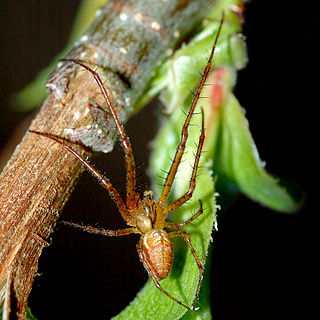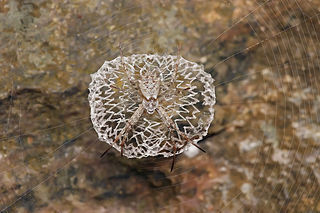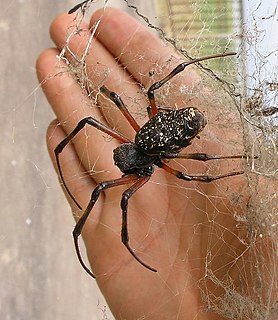
The genus Argiope includes rather large spiders that often have a strikingly coloured abdomen. These spiders are distributed throughout the world. Most countries in tropical or temperate climates host one or more species that are similar in appearance. The etymology of Argiope is from a Latin word argentum meaning silver. The carapace of Argiope species is typically covered in silvery hairs, and when crawling in the sun, they reflect it in a way that gives them a metallic, white appearance.

Orb-weaver spiders are members of the spider family Araneidae. They are the most common group of builders of spiral wheel-shaped webs often found in gardens, fields and forest. "Orb" can in English mean "circular", hence the English name of the group. Araneids have eight similar eyes, hairy or spiny legs, and no stridulating organs.

Long-jawed orb weavers or long jawed spiders (Tetragnathidae) is a family of araneomorph spiders first described by Anton Menge in 1866. They have elongated bodies, legs, and chelicerae, and build small orb webs with an open hub with few, wide-set radii and spirals with no signal line or retreat. Some species are often found in long vegetation near water.

Gasteracantha is a genus of orb-weaver spiders first named by Carl Jakob Sundevall in 1833. The females of most species are brightly colored with six prominent spines on their broad, hardened, shell-like abdomens. The name Gasteracantha is derived from the Greek gaster (γαστήρ), meaning "belly, abdomen", and akantha (άκανθα), meaning "thorn, spine". Spiny-backed orb-weavers are sometimes colloquially called "crab spiders" because of their shape, but they are not closely related to the true crab spiders. Other colloquial names for certain species include thorn spider, star spider, kite spider, or jewel spider.

A web decoration or stabilimentum is a conspicuous silk structure included in the webs of some species of orb-web spider. Its function is a subject of debate.

A bolas spider is a member of the orb-weaver spider that, instead of spinning a typical orb web, hunts by using one or more sticky "capture blobs" on the end of a silk line, known as a "bolas". By swinging the bolas at flying male moths or moth flies nearby, the spider may snag its prey rather like a fisherman snagging a fish on a hook. Because of this, they are also called angling or fishing spiders. The prey is lured to the spider by the production of up to three sex pheromone-analogues.

Nephilinae is a spider subfamily of the family Araneidae with seven genera. The various genera in Nephilinae were formerly grouped in the family Nephilidae, and before that in the Tetragnathidae and in the Araneidae. All nephiline genera partially renew their webs. Spiders in the subfamily Nephilinae are commonly referred to as golden orb-weavers.

Ordgarius is a genus of orb-weaver spiders first described by Eugen von Keyserling in 1886. Adult females of the genus are bolas spiders, capturing their prey with one or more sticky drops at the end of a single line of silk rather than in a web. Males and juvenile females capture their prey directly with their legs.

Arachnura, also known as drag-tailed spider, scorpion-tailed spider and scorpion spider, is a genus of orb-weaver spiders that was first described by A. Vinson in 1863. They are distributed across Australasia, Southern and Eastern Asia with one species from Africa. Females can grow up to 1 to 3 centimetres long, while males reach only 2 millimetres (0.079 in) long. The name is a combination of the Ancient Greek "arachne-" (ἀράχνη) and "uro" (οὐρά), meaning "tail". The tails are only present on females, but unlike the common names suggests, these spiders aren't related to scorpions. They curl up their tails when disturbed, but they are completely harmless. Bites are rare, and result in minor symptoms such as local pain and swelling. They stay at the middle of their web day and night, and their bodies mimic plant litter, such as fallen flowers, twigs, or dead leaves.
Nephilengys is a genus of tropical spiders of the family Araneidae, consisting of two currently described species. The genus Nephilingis has been split off from this genus. Both genera have been called hermit spiders from the habit staying in their retreats during the day; the name eunuch spiders has been used for Nephilengys alone. Males may sever parts of their palpal bulbs after copulation.

Dolichognatha is a genus of tropical and subtropical long-jawed orb-weavers that was first described by Octavius Pickard-Cambridge in 1869. Originally placed with the Archaeidae, it was transferred to the Araneidae in 1967, and to the Tetragnathidae in 1981.

Phonognatha is a genus of South Pacific orb-weaver spiders first described by Eugène Simon in 1895. It was originally placed with the long-jawed orb weavers, and was moved to Araneidae in 2008.

Gnolus is a genus of South American orb-weaver spiders that was first described by Eugène Louis Simon in 1879. Originally placed with the orb-weaving spiders, it was transferred to the pirate spiders in 1993, but moved back to orb-weaver family in 2012.

Nephilingis is a genus of spiders in the family Araneidae. It was split off from the genus Nephilengys in 2006. Both genera have been called hermit spiders from the habit of staying in their retreats during the day; alternatively the name "hermit spider" may be reserved for Nephilingis, with Nephilengys species called "eunuch spiders".

Macracantha is a genus of Asian orb-weaver spiders recognized as containing a single species, Macracantha arcuata. Macracantha is notable for the extremely long, curved spines on the abdomens of female members of the genus; Eugène Simon created the taxon name from the Greek words μακρός and ἄκανθα (spine). It occurs from India and China through Southeast Asia to Borneo.

Pasilobus is a genus of orb-weaver spiders first described by Eugène Simon in 1895.

Cyrtarachninae is a subfamily of spiders in the family Araneidae. The group has been circumscribed in several different ways. It originated as the group Cyrtarachneae, described by Eugène Simon in 1892. The group was later treated at different ranks: as a tribe, both under Simon's name and as Cyrtarachnini, and as the subfamily Cyrtarachninae. Circumscriptions have varied. The broadest circumscription, Cyrtarachninae sensu lato (s.l.), includes three of Simon's original groups, including the bolas spiders. Unlike most araneids, members of the subfamily do not construct orb webs, some not using webs at all to capture prey, some using one or more sticky drops on a single line, while others construct webs with few widely spaced non-spiral threads, some triangular. Many have been shown to attract prey by producing analogues of insect sex pheromones, particularly to attract male moths. Adult females may mimic snails, bird droppings and other objects, and so are able to remain exposed during the day time, capturing prey at night.

Ordgarius sexspinosus is a species of spider in the orb-weaver spider family Araneidae, found from India to Japan and Indonesia. O. monstrosus is a bolas spider. Rather than using a web, adult females catch their prey by using a line with one or two sticky drops which they swing.

Pasilobus hupingensis is a species of spider in the orb-weaver spider family Araneidae, found in China and Japan. Females of the genus Pasilobus construct "spanning-thread webs" with only two sectors, making them appear triangular. Widely spaced threads with sticky drops span the three radii of these webs. One end is attached in such a way that it readily breaks free. When a prey item is caught on one of these threads, the line parts at this end and the prey hangs from the web until it is hauled up by the spider.















